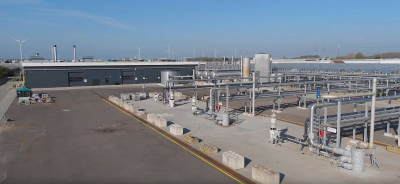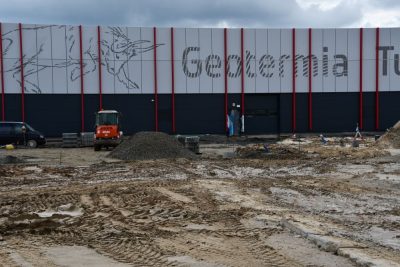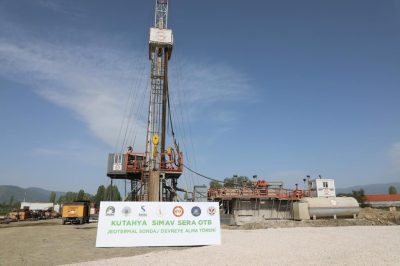Artificial lift technology helps unlock the full potential of geothermal water extraction
Modular designs, machine learning, and real-time performance monitoring are helping to tackle the challenges of ESP technology in geothermal settings.
Electrical submersible pump (ESP) technology has played a big role in expanding the utilization of geothermal resources worldwide, particularly for direct heating applications. However, the extreme conditions of geothermal environments introduce challenges to ESP design and operations. Efficiency, operations, and maintenance factors also have to be considered to maximize the economics of geothermal projects involving ESPs.
In this guest article written by Hans Sjerps, Frank Corredor, Juan Pablo Atencia, and Alasdair McPhail, we go over the many common technical challenges of ESP operations and how Halliburton addresses these through tailor-made solutions.
In the 1990s, geothermal operators discovered the benefits of electric submersible pumps (ESPs), an artificial lift technology, for geothermal water extraction. These pumps, tried and proven in the oilfield to maximize hydrocarbon extraction, drew upon established techniques to remove subsurface fluids, which made them attractive to smaller-scale operations such as local heating networks and wellness baths.
As geothermal operators pushed the limits of traditional applications and began exploring deeper depths, ESP use expanded to handle more significant outputs of up to 150 liters per second and withstand temperatures of 150°C.
However, traditional ESPs hit their limits in geothermal applications. Extreme temperatures, corrosive brines, and strenuous operating conditions pose challenges and require operators to seek hardier solutions. The fluid extracted from geothermal wells lacks oil, which affects lubrication. Limestone-derived calcium carbonates could also cause scaling in essential pump and seal areas.
While traditional high-flow ESP pumps perform well in standard water lifting, they risk potential failure under these intense geothermal conditions. In seasonal temperature changes, motor bearings and power connectors may experience even more stress that could cause failure.
The risks of bolted bowl-type pumps highlight the need for tailored solutions
The geothermal industry originally adapted bolted bowl-type pumps, which originated from shallow cold water lifting applications. However, their limitations and safety concerns meant the industry required a new solution to withstand the demands of deep-set geothermal applications. Otherwise, operators could experience equipment failures due to the pressure, temperature, and vibrations inherent in geothermal wells.
A notable incident with a customer in Europe highlighted the risks inherent in bolted bowl-type pumps. When a pump failed on site, the operator lost equipment downhole. Upon further inspection, the operator discovered vibrations due to the pressure in the well dislodging the downhole-facing bolts and cracking the bowls due to metal fatigue. This underscored the dangers of using pumps not designed for the conditions of deep geothermal wells.
Cost and space create concerns for geothermal projects
Geothermal projects require the utmost efficiency to help ensure a return on investment. However, traditional geothermal systems often use technology better suited to the oilfield, which results in less efficiency.
For example, conventional geothermal systems use round power cables to maintain balanced electromagnetic fields, which prolongs submersible motors’ longevity and efficiency. However, these round cables occupy double the space compared to flat cables. With a frequency controller integrated into the ESP to correct imbalances caused by flat cables, operators can optimize the space and save power, reducing costs.
Thermal cycling and scale resistance also increase costs for geothermal operators during geothermal fluid extraction. Traditional pump inlets often obstruct fluid movement, which results in cavitation and scale formation due to pressure drops. A larger inflow area for ESPs than standard intakes can address the issue of high flow rates in small casing sizes and help lower costs.
Another way to reduce costs involves the reduction of the lifting requirement. Traditional intake design requires up to 50 kW more power to lift and meet high geothermal flow demands. However, a reduction of 2-bars at a flow rate of 400 m3/h (111 L/s necessitates 45 kW less lifting power applied at the surface. Calculated at €0.30 per kWh over a year, this equates to about €128,000 saved per year.
In addition, geothermal operations encompass power generation and direct heating, which demand versatile flow rates with seasonal variations in heat demand. Operators could reduce costs through a device integrated into the ESP that fine-tunes motor settings to suit load condition fluctuations, a capability beyond the reach of conventional frequency drive controllers. Field trials for these devices demonstrated up to 50 kW in achieved power savings for a 1650 HP motor at 40 Hz, compared to the maximum speed of 60 Hz, which translates to an estimated annual power cost reduction of around €130,000.
Software assists with real-time monitoring and management of ESPs
Project economics, pump performance, and overall operation uptime benefit from real-time observation. They allow operators to detect abnormal events early to prevent a shutdown.
SCADA platforms for real-time monitoring must include high-resolution data collection, visualization dashboards, key performance indicator measurement, and remote controls within a 24/7/365 cloud-based environment to ensure that data remains available and secured via private VPN-encrypted communications. The cloud-based environment facilitates monitoring and management regardless of location and/or mobile device.
Without these features, operators will fall short of their objectives and cannot enable continuous real-time monitoring and management of geothermal plants and ESP systems.
Machine learning algorithms and techniques further enhance ESP operations. They serve as advanced engineering tools for baseline conditions related to flow, pressure, and temperature that elevate the online platform’s data comparison features. Through these data analysis and processing advancements, the geothermal industry can now use pump performance tracking and well inflow performance monitoring. It also allows the establishment of power consumption benchmarks and prevents electromechanical anomalies.
Furthermore, machine learning provides virtual parameters with less than 5% error margins compared to actual downhole gauges. Virtual sensors, combined with the physical sensor downhole, could, for example, detect a pump inlet plugging to schedule maintenance. The virtual sensors can take over for data reporting to the mining authorities without the need to pull a still-running pumping system in case the physical sensor fails.
Dedicated surveillance engineers perform data analysis, pump health assessments, and ESP trend analysis within the platform. They base their analysis on a geothermal plant-specific operations playbook of best practices and historical events, which allows for the consistent execution of technical recommendations and the preservation of system integrity for operational scenarios. The collaborative efforts between operators and monitoring services, supported by digital and analytical tools, extend the operational runtime of ESPs.
Unlocking geothermal potential with engineered ESPs
To meet the challenges of harsh geothermal environments, operators require ESPs that can withstand the demands of deep geothermal wells and tackle issues such as lubrication, scaling, and thermal stress.
When Halliburton engineers developed the GeoESP® pump system, they began with a framework that accounted for geothermal environments and prioritized safety, flexibility, and efficiency. The GeoESP system emerged as a versatile, modular, and robust technology suite that consists of the GeoESP pump and related components: the GeoESP intake, GeoESP box test container, GeoController® surface package, and GeoESP skid. These modules work with the Intelevate™ digital platform to help operators adapt to various geothermal environments, maximize geothermal water extraction, and minimize input power costs.
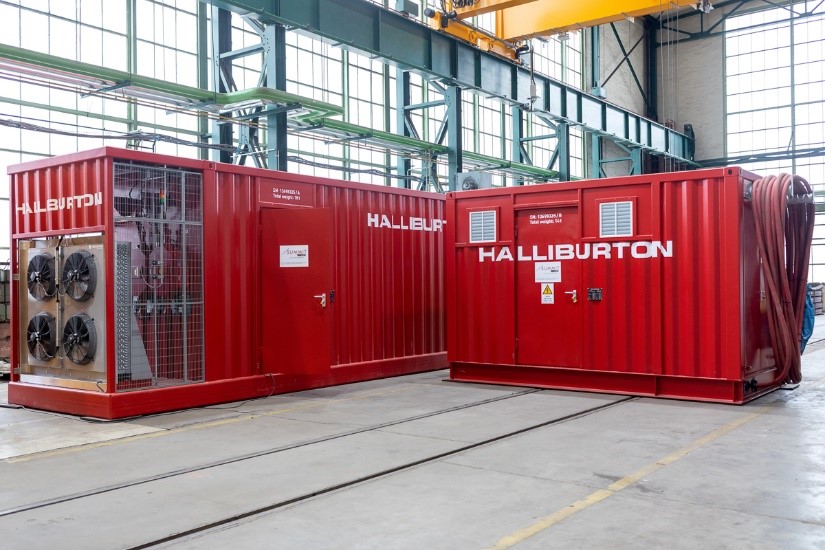
From its inception, engineers designed the GeoESP pump to help overcome the limitations and safety issues associated with the bolted-bowl pumps commonly used in the water-lifting industry. The redesign includes additional housing for the bowls to prevent lateral movements from long tubing risers that could lead to metal fatigue, which results in dislodged bolts. The pump housings can withstand differential pressures up to 193 bar—far beyond the requirements of geothermal applications. Moreover, flanged connections with upward-facing bolts with a centralizer ring secure the pump stages, reducing the risk of loose bolts.
Because engineers designed the GeoESP system as a modular solution, operators can use pre-defined configurations with five, seven, 11, or 14 pump stages to handle flow rates from 20 to 160 liters per second. The standard outer diameter of 9.5 inches grants the GeoESP system the adaptability to handle various well inflow conditions.
It simplifies the adaptation process at the well site for a range of flow rates and lifting requirements. It also ensures compatibility with a single set of centralizers for all pump configurations. For customers with multiple wells, standardization also helps them reduce the amount of inventory to a single GeoESP system.
Modular ESP components enhance safety, reduce costs
Halliburton builds GeoESP system components with high-quality, heat-resistant (150-250?C, 303-482?F BHT) materials that resist scale, corrosion, and abrasion with additional new and innovative technologies to address the unique demands of geothermal applications. These modular components enhance safety and reduce power input costs, as well as improve efficiency at geothermal well sites:
- GeoESP intake: deep set ESPs must handle high flow rates from small casing diameters, but small intake sizes can pose a challenge. In addition, traditional pump inlets often obstruct fluid movement, which may lead to cavitation and scale formation due to pressure drops. The GeoESP intake, an easy-to-change, interchangeable, modular pump intake, drew inspiration from cross-industry designs like medical technology. The system boasts a 500% larger inflow area than standard intakes, with pressure loss reductions by over 30% for flow rates of around 10 liters per second. It features a screened housing to protect against small-sized solids and debris. Optimized inflow geometry reduces pressure drop for increased energy savings and further mitigates the development of scale and casing erosion around the pump inlet.
- GeoESP box test container: A simple, 2000 kVA plug-and-play surface solution for inflow performance tests helps operators save time and money. The GeoESP box test container can also be used as a final, long-term solution that could save well costs related to surface plant construction, project engineering, and time to operation.
- GeoController surface package: Geothermal operations encompass power generation and direct heating. The operations demand versatile flow rates due to seasonal variations in heat demand. The GeoESP system now includes the GeoController surface package. This device fine-tunes the GeoESP motor settings to suit load condition fluctuations, a capability beyond the reach of conventional frequency drive controllers. Field trials demonstrated that the GeoController surface package can achieve up to 50 kW in power savings for a 1650HP motor at 40Hz, compared to the maximum speed of 60Hz. This translates to an estimated annual power cost reduction of €130,000. The GeoController surface package facilitates seamless communication between various systems, with efficient data processing, real-time sensor monitoring, and remote interventions for advanced GeoESP operations, protections, and optimized power consumption.
- GeoESP skid: Designed to increase the safety and speed of ESP execution, the GeoESP skid safeguards GeoESP equipment amid storage, transportation, and well-site preparation. It resists bending and impact, and provides safer built-in design features. The GeoESP skid helps the ESP arrive at the well-site ready for assembly and decreases the personnel required to handle and lift. One person can prepare rig-up without a forklift or crane for additional assistance. The GeoESP skid simplifies long-term storage through its stackability, ability to enable oil flushing, and leakage control.
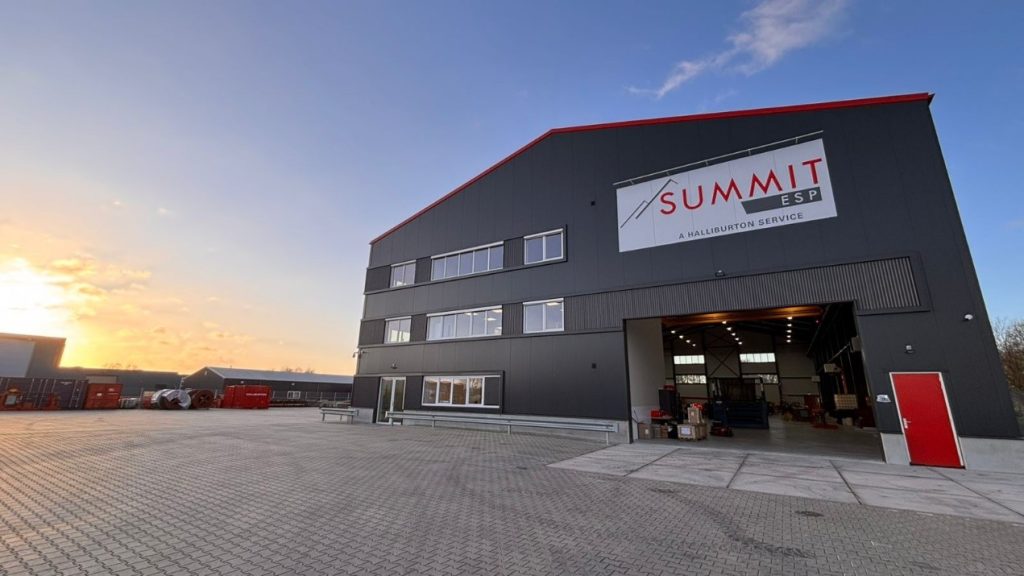
Operators save over €1.5 million with GeoESP system
The proof of the efficacy of designed artificial lift equipment – in particular, the GeoESP system – lies in how much operators save when they avoid preventable losses due to unsuitable pumps.
For example, one German geothermal operator relied on two ESPs to extract water but transitioned to a single GeoESP system with a broader operational range. While the engineer evaluated the equipment for installation, the engineer identified unrepairable power quality issues in the low-voltage variable-speed drive (VSD) output, which would result in six months of downtime while they waited for new equipment. Not only would this downtime affect costs, but it would also potentially leave thousands of Germans without heat.
However, the operator installed a GeoESP box test container, which provided a seamless surface solution amid the VSD replacement process. The GeoESP box test container can adapt to different grid voltages throughout Europe and support the geothermal plant while the team replaces the VSD. The GeoController surface package provided the operator with a quick, easy interface for field service and connected to the Intelevate digital platform, which allowed them to analyze real-time data from a mobile phone. This expedited deployment of the box test container averted a potential loss of over €1.5 million in downtime and associated costs.
In another scenario, a geothermal operator experienced three ESP failures within 60 days due to scale accumulation, which led to seized systems and broken shafts. The financial impact of such failures could have escalated to €500,000, which included pull expenses, equipment replacement, and operational downtime. The introduction of a GeoESP intake and system monitoring via the Intelevate platform allowed for early detection of scale formation. The operator implemented suggested preventative measures, extended the run time, and enhanced the operation’s overall efficiency, which resulted in cost savings.
As more governments and consumers look to geothermal as a cost-effective, reliable power source, the ability to keep costs down and continue operations will boost the industry. Artificial lift solutions tailored to geothermal applications, such as the GeoESP system, help operators unlock geothermal’s full potential, increase safety and efficiency, and reduce costs.
To learn more about the GeoESP system and Halliburton’s geothermal capabilities, visit Halliburton.com/geothermal.








